416th Fighter Squadron
| 416th Fighter Squadron | |
|---|---|
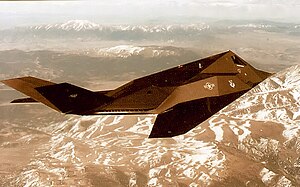 Lockheed F-117A Nighthawk - 81-10798 flying over the Sierra Mountains. | |
| Active | 1943–1993 |
| Country | United States |
| Branch | United States Air Force |
| Type | Fighter Squadron |
| Engagements | World War II (EAME Theater) Vietnam War 1991 Gulf War (Defense of Saudi Arabia; Liberation of Kuwait) |
| Decorations | Distinguished Unit Citation Air Force Outstanding Unit Award (2x) |
| Insignia | |
| 416th Fighter Squadron emblem |  |
The 416th Fighter Squadron is an inactive United States Air Force unit. Its last assignment was with the 49th Fighter Wing at Holloman Air Force Base, New Mexico. The squadron was inactivated on 1 July 1993.
History
World War II
Established in February 1943 as the 416th Night Fighter Squadron, assigned to the 481st Night Fighter Operational Training Group, Orlando Air Base, Florida for training. The 417th was the first USAAF dedicated night fighter squadron formed. Trained in the Douglas P-70, a modified A-20 Havoc bomber using a U.S. version of the British Mk IV radar. At the time the P-70 was the only American night fighter available.[1]
After completing its initial training by April, the squadron crossed the Atlantic on the RMS Queen Elizabeth and landed in the United Kingdom on 11 May. Pausing briefly for training under VIII Fighter Command (attached to the Royal Air Force).[2] There, it was equipped with RAF Bristol Beaufighters through a "reverse Lend-Lease" program until an American aircraft could be produced.[1] Upon arrival in England the squadron received additional training with Royal Air Force night fighter units at several bases in early 1943 achieving the first victory on 24 July. Through the summer, they conducted daytime convoy escort and strike missions, but thereafter flew primarily at night.[1]
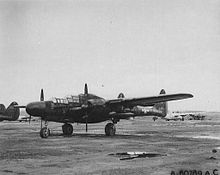
The unit then moved to North Africa for operations with Twelfth Air Force. There, the squadron fell under the operational control of the Northwest African Coastal Air Force, a joint inter-allied organization with British, Free-French, and other American units.[2] Carried out defensive night patrols over Allied held territory during the North African campaign, also conducted night interdiction raids on German positions in Algeria and Tunisia.[1]
The defeat of German, Italian, and Vichy French forces in North Africa allowed the 416th to move with other allied forces into Italy in September 1943. During its first year there, the squadron patrolled harbors and escorted shipping; however, in September 1944 the 416th shifted to more aggressive activities to provide defensive cover for the Fifth Army and make intruder sweeps into enemy territory.[2] Also continued defensive patrols and offensive night attacks on Axis positions on Sardinia, Corsica, and in Southern France.[1]
With the fall of Germany, the unit became part of the United States Air Forces in Europe army of occupation. Moved in August 1945 to AAF Horsching, Austria, for occupation duties. A year later, the 416th relocated to AAF Schweinfurt, Germany, where it inactivated on 9 November 1946.[1][2]
Cold War
Reactivated in 1953 at George AFB, California as an F-86 Sabre Fighter-Bomber Squadron. Initially equipped with F-51D Mustang aircraft, the 416th quickly converted to F-86F Sabre jet aircraft and started participating in air defense operations, exercises, and firepower demonstrations. Then in September 1953, the 416th received Arctic indoctrination at Eielson AFB, Alaska. Next, the squadron joined its parent unit, the 21st Fighter-Bomber Group, in Operation Boxkite at North Field, South Carolina from 17 April to 15 May 1954.[2]
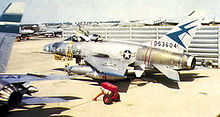
The 416th moved to France in November–December 1954. For this move, the ground echelon left George AFB, California, on 26 November and arrived at Toul-Rosieres Air Base on 12 December. The flight echelon left George on 13 December and traveled to France by the northern air route. Bad weather, however, delayed the movement, and the flight element did not reach Toul-Rosiere until 22 February 1955. From then until December 1957, the squadron participated in NATO tactical operations and exercises, stood air defense alert, and periodically deployed aircraft and crews to Wheelus AB, Libya, for fighter weapons training. The unit was not operational from 10 January to 8 February 1958.[2]
On 25 March 1958, the 416th activated under Fifth Air Force at Misawa Air Base, Japan, where it started converting from F-84G Thunderjets to F-100 Super Sabres. Later in July, the squadron joined the 21st Fighter-Bomber Wing; however, the USAF directed the 416th to transfer its F-100s to another unit. This order temporarily interrupted its conversion and forced the 416th to fly F-84Gs until May 1959, when a full complement of F-100s arrived. During this period in the Far East, the units crews flew tactical operations and exercises in South Korea, Taiwan, Okinawa, Singapore, the Philippines, and other exotic places in the Far East.[2]
Vietnam War
In June 1964, the 416th moved to England AFB, Louisiana, where it joined the 3d Tactical Fighter Wing (Tactical Air Command) for training. From 17 October through 7 December 1964, the squadron deployed a flight to Takhli Royal Thai Air Force Base, Thailand, where it operated under various higher headquarters. This deployment, however, was just a precursor to even greater involvement in Southeast Asia (SEA) as the entire squadron deployed there in March 1965. It operated in turn from Clark AB, Philippines, Da Nang AB, South Vietnam, Bien Hoa AB, South Vietnam, and again at Clark until July 1965, when it returned to England AFB. While in SEA, the unit flew 1,711 combat sorties between 19 March and 14 July to fly flak suppression, weather reconnaissance, MiG combat air patrol, and air strike missions.[2]
The 416th deployed with the 3 TFW to SEA in November 1965 to Tan Son Nhut AB, South Vietnam. There, the 6250th Combat Support Group controlled the squadron's operations until June 1966, when it rejoined the 3 TFW at Bien Hoa AB. The 416th remained at Bien Hoa until its April 1967 reassignment to the 37th TFW. In May, the squadron moved to Phù Cát Air Base without a break in combat missions.[2]
Forward air control assignments
On 15 June 1967, Detachment 1, 416 TFS became the nucleus of Commando Sabre, a special activity using F-100F two-seat trainers to fly fast Forward Air Control (FAC) operations under the call sign "Misty." From the 16th to the 28th, they learned aerial refueling techniques. The unit's participation in Commando Sabre even continued after a move to Tuy Hoa AB and reassignment to the 31 TFW. At that time, operational control over Commando Sabre passed from the 37th TFW to the 31st TFW.[2][3]
As the U.S. Air Force's original Fast FAC effort, the "Misties" were pioneers. The original 16 "Misties" were flight leader qualified with over 100 combat missions to their credit; four of them were already trained as FACs. After this quartet trained the other dozen, planes from this FAC detachment would fly missions into North Vietnam's Route Package 1 or against the defenses of the Ho Chi Minh Trail in Steel Tiger. The "Misty" pilots committed to serving for either 120 days or 75 FAC sorties, whichever came first. Their standard operating profile of 450 KIAS at 4,500 feet altitude allowed their survival where Slow FACs dared not venture.[4]
The "Misties" having proved their worth, an attempt to expand the detachment began in August 1967. Only one additional F-100F was located to transfer to the unit. Nevertheless, by April 1968, "Misty" FACs had flown 565 FAC sorties against the Mu Gia Pass and the Ban Karai Pass and directed 850 air strikes against this northern end of the Ho Chi Minh Trail. The 1 April 1968 cessation of bombing north of the 20th Parallel intensified operations in Route Pack 1 and increased the "Misty" FAC workload.[5]
On 1 June 1968, the "Misties" began the loan of their services to the U.S. Navy for their Operation Sea Dragon. On 11 June 1968, the "Misties" began the first night Fast FAC missions of the war.[4] On the nights of 13 and 14 June, they tested a Starlight Scope for FAC operations. The preliminary results seemed promising, so the "Misties" began flying missions with the Scope in the rear seat with the observer on 8 July. As it turned out, the Scope was too bulky for easy use, and did not work in moonless periods. A "Misty" was lost in action on 16 August 1968, and another the following night. The night FAC mission not having observed anything more than an ordinary fighter pilot, it was cancelled after this second loss.[6]
On 12 August 1968, the "Misty" FACs began training two aircraft commanders from the 366th Fighter Wing as FACs. On 2 September 1968, the first "Stormy" FACs began FACing in Route Pack 1.[7]
With the 1 November 1968 halt of bombing North Vietnamese targets, the "Misties" ceased operations in Route Pack 1 and shifted their FAC mission towards the Ho Chi Minh Trail. By that time, the "Misty" FACs had flown 1,441 combat sorties, directed 3,988 air strikes, and lost nine airplanes.[8]
From 1 November 1968 until June 1969, the "Misties" flew 1,530 combat sorties and directed 2,321 air strikes against the Ho Chi Minh Trail.[9]
Plagued by shortages of aircraft, the "Misties" stood down on 14 May 1970. By that time, about a quarter of the 93 "Misty" FAC pilots had been shot down, though most had been rescued. The Fast FAC concept having been proven, other Fast FAC units had taken up the fight.[4]
In the meantime, the 416th still flew regular combat missions, logging its 30,000th SEA combat sortie on 20 April 1970. Most of those missions involved close air support or direct air support. The unit stood down from combat operations on 5 September 1970, and its resources were transferred to other units.[2]
Tactical Air Command
On 28 September 1970, the squadron moved without personnel to England AFB, Louisiana. Anticipating the 416th's reassignment, the 4403d TFW at England AFB began forming a new squadron cadre in August 1970. This cadre started training its pilots to instructor status and was immediately available when the Air Force transferred the unit to England that September. After receiving more equipment and people, the 416th achieved combat ready status and began normal participation in exercises and other tactical operations.[2]
Inactivation appeared imminent again as the Air Force phased the last F-100s out of its inventory. By December 1971, the 416th was the only active flying squadron in the 4403d TFW. On 1 April 1972, its operational training commitment ended, and as a result the Air Force transferred all personnel to other units and aircraft to the Air National Guard. From May 1972 until its 1 July inactivation, the 416th served as a holding unit for a new A-7D Corsair II squadron that would replace it.[2]
Re-designated the 416th Tactical Fighter Training Squadron (TFTS), the unit activated again on 15 March 1979 under the 479th Tactical Training Wing at Holloman AFB, New Mexico. At Holloman, the squadron used AT-38B aircraft to provide transitional training to new pilots preparing for assignment to operational fighter wings. The 416th inactivated on 1 September 1983 as the 433d TFTS assumed its mission.[2]
F-117 Development/Operations

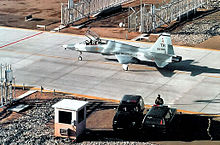
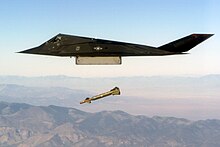
Activated by Tactical Air Command at Groom Lake, Nevada as a classified unit on 15 October 1979, designated as P-Unit. Received A-7D Corsair II tactical fighters from 23d Tactical Fighter Wing, England AFB, Louisiana to use as training aircraft for Lockheed F-117A Nighthawk stealth fighter, then under development. Performed training mission for pilots to transition to single-seat, subsonic F-117. Was given designation of 4451st Tactical Squadron, 11 July 1981, and assigned to 4450th Tactical Group which was formed to bring the F-117 from development to operational status.[10]
Was moved to Tonopah Test Range Airport on 28 October 1983, performing training missions with the F-117A in a clandestine environment. Performed dual mission of training F-117 pilots with the A-7Ds as well as providing a cover story for the classified Stealth Fighter project. All Tonopah training flights conducted at night under the cover of darkness until late 1988. On 10 November 1988, the Air Force brought the F-117A from behind a "black veil" by publicly acknowledging its existence, but provided few details about it. The official confirmation of the F-117A's existence, however, had little impact on Tonopah operations. Pilots began occasionally flying the F-117A during the day, but personnel were still ferried to and from work each Monday and Friday from Nellis. Everyone associated with the project was still forbidden to talk about what they did for a living, and the program remained shrouded in secrecy.[10]
Operated at Tonopah with A-7Ds until late 1989 when F-117 project was revealed to the public. Retired its A-7Ds, being the last active duty USAF squadron to operate the A-7D, and transitioned to the Northrup T-38A Talons. The squadron was re-designated as the 416th Tactical Fighter Squadron (Ghostriders) on 5 October 1989 when the 4450th Tactical Group was inactivated, and F-117A operations coming under the 37th Tactical Fighter Wing. There, it assumed the mission of the 4451st Test Squadron to become one of two operational F-117A Stealth Fighter squadrons.[2]
On 19 December 1989, just 13 months after the Pentagon had disclosed the existence of the F-117A, squadron aircraft were first used in combat during Operation Just Cause. In mid-December 1990, was deployed to King Khalid International Airport, Saudi Arabia as part of the buildup of United States forces prior to Operation Desert Storm. Flew combat operations over Iraq against high-priority targets January–February 1991. After combat operations ceased in February 1991, some wing personnel and aircraft remained on indefinite alert in Saudi Arabia as a component member of the post-Desert Storm task force in Southwest Asia, although most returned to Tonopah by the end of March.[11]
Most of the F-117As deployed to Saudi Arabia returned home to Tonopah in early April 1991, although a few remained as part of the post-Desert Storm task force in Southwest Asia.[11] After Desert Storm, the Air Force re-designated the squadron as the 416th Fighter Squadron on 1 October 1991. The squadron realigned from under the wing as a subordinate of the 37th Operations Group on 1 November 1991.[2]
In 1992, as part of the post Cold War budget cutbacks in the Air Force, the F-117As were moved to Holloman AFB, New Mexico; the 37th Fighter Wing and its subordinate organizations were inactivated and the aircraft, equipment, personnel and mission of the squadron were re-designated as the 8th Fighter Squadron, being assigned to the 49th Operations Group at Holloman AFB.[11]
Lineage
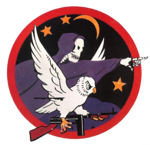

- Constituted as the 416th Night Fighter Squadron on 17 February 1943
- Activated on 20 February 1943
- Inactivated on 9 November 1946
- Re-designated as: 416th Fighter-Bomber Squadron on 15 November 1952
- Activated on 1 January 1953
- Inactivated on 8 February 1958
- Activated on 25 March 1958.
- Re-designated as: 416th Tactical Fighter Squadron on 1 July 1958
- Inactivated on: 16 June 1964
- Activated on: 15 April 1967
- Inactivated on: 27 May 1969
- Re-designated as: 416th Tactical Training Squadron on 15 March 1979 and activated
- Established by Tactical Air Command as P-Unit, 15 October 1979
- Re-designated: 4451st Tactical Squadron*, 11 July 1981
- Inactivated on: 5 October 1989
- Re-designated as: 416th Tactical Fighter Squadron* on 15 September 1989
- Re-activated on 5 October 1989, Assuming personnel and equipment of 4451st Tactical Squadron
- Re-designated as: 416th Fighter Squadron 1 November 1991
- Inactivated on 1 July 1993[12][13]
- Personnel and equipment re-designated 8th Fighter Squadron
* Note: No official lineage or history between 4451st Tactical Squadron and 416th Tactical Fighter Squadron
Assignments
|
|
Stations
|
|
Aircraft
|
|
See also
References
![]() This article incorporates public domain material from the Air Force Historical Research Agency
This article incorporates public domain material from the Air Force Historical Research Agency
- ^ a b c d e f Northrop P-61 Black Widow—The Complete History and Combat Record, Garry R. Pape, John M. Campbell and Donna Campbell, Motorbooks International, 1991.
- ^ a b c d e f g h i j k l m n o p History and Lineage of the F-117A Stealth Fighter Organizations, Special Study HO-91-2, Office of History, Headquarters 37th Fighter Wing, Twelfth Air Force, Tactical Air Command, December 1991
- ^ Schlight, John (1969). Project CHECO Report: JET FORWARD AIR CONTROLLERS IN SEASIA. ASIN B00ARRLMEY. Pp. 1 - 3.
- ^ a b c Rowley, Ralph A. (1975). The Air Force in Southeast Asia: FAC Operations 1965-1970. U.S. Office of Air Force History. Military Bookshop (2011 reprint). ISBNs 1780396562, 978-1780396569. Pages 173 - 188.
- ^ Schlight, John (1969). Project CHECO Report: JET FORWARD AIR CONTROLLERS IN SEASIA." Headquarters Pacific Air Force. ASIN B00ARRLMEY. Pages 1 - 15.
- ^ Schlight, John (1969). Project CHECO Report: JET FORWARD AIR CONTROLLERS IN SEASIA." Headquarters Pacific Air Force. ASIN B00ARRLMEY. Pages 16 - 19.
- ^ Schlight, John (1969). Project CHECO Report: JET FORWARD AIR CONTROLLERS IN SEASIA." Headquarters Pacific Air Force. ASIN B00ARRLMEY. Page 23.
- ^ Schlight, John (1969). Project CHECO Report: JET FORWARD AIR CONTROLLERS IN SEASIA." Headquarters Pacific Air Force. ASIN B00ARRLMEY. Page 21.
- ^ Schlight, John (1969). Project CHECO Report: JET FORWARD AIR CONTROLLERS IN SEASIA." Headquarters Pacific Air Force. ASIN B00ARRLMEY. Page 26.
- ^ a b F-117a.com
- ^ a b c Peebles, Curtis, (1999), Dark Eagles, Presidio Press; Revised edition, ISBN 0-89141-696-X
- ^ a b c d e Maurer, Maurer, ed. (1982) [1969]. Combat Squadrons of the Air Force, World War II (PDF) (reprint ed.). Washington, DC: Office of Air Force History. ISBN 0-405-12194-6. LCCN 70605402. OCLC 72556.
- ^ a b c d e Rogers, Brian (2005). United States Air Force Unit Designations Since 1978. Hinkley, England: Midland Publications. ISBN 1-85780-197-0.


